Roof cleaning mistakes often start with the wrong method, the wrong chemical, or skipped gutter care, and each error can shorten roof life while creating secondary plumbing risks. This article explains the most common roof cleaning mistakes, why they happen, the mechanisms by which they damage roofing materials and plumbing systems, and practical prevention steps homeowners can take. You will learn how pressure washing roof damage, how chemical runoff can corrode gutters and drains, why neglecting downspouts leads to basement seepage, and when to call professionals. Practical sections cover safety errors, timing and weather impacts, and a toolkit of best practices designed to protect shingles, gutters, and the home’s plumbing network. Throughout, target topics like pressure washing roof damage, soft wash roof cleaning benefits, clogged gutters and water damage, and roof cleaning safety protocols are woven into clear guidance so you can avoid costly repairs and protect warranty coverage.
Why Is Pressure Washing a Common Roof Cleaning Mistake?
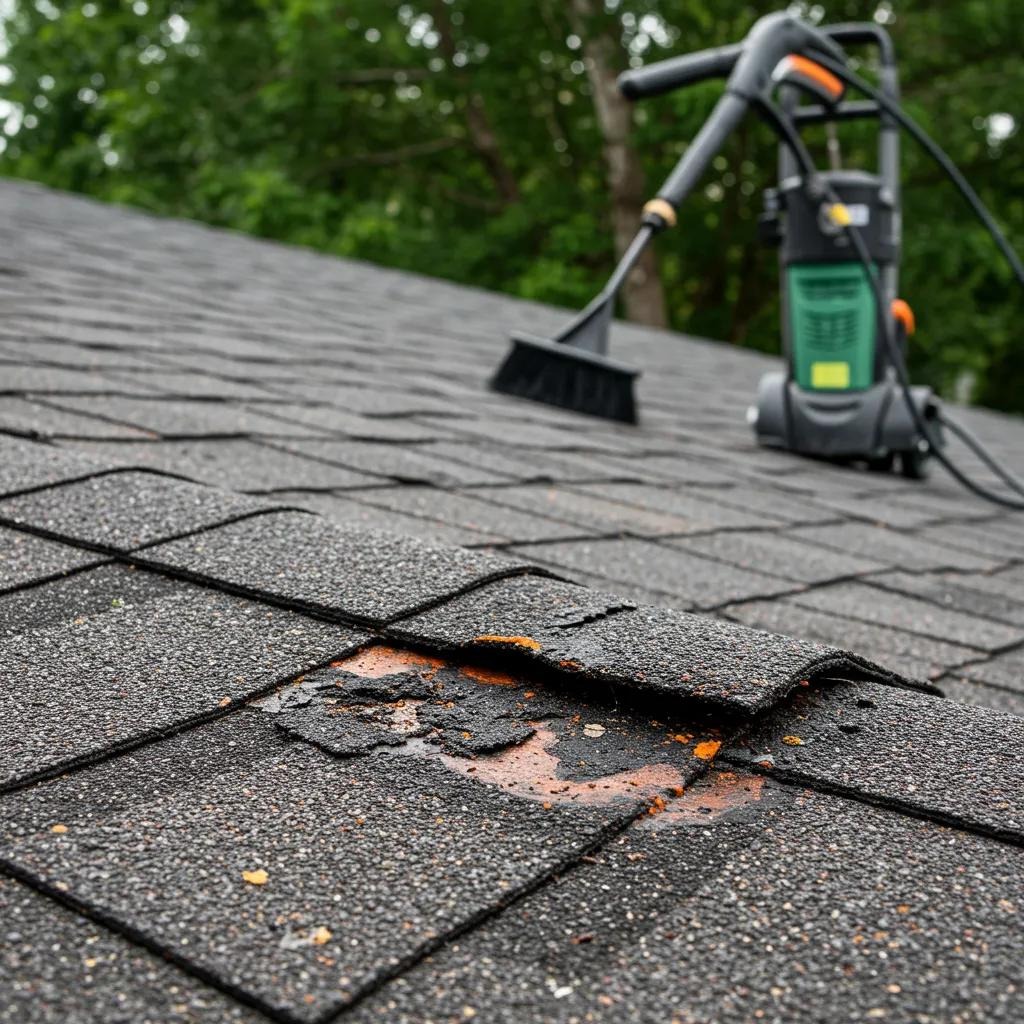
Pressure washing is defined as using high-pressure water streams to remove surface growth and debris, but it often damages roofing by removing protective granules and lifting shingles. The mechanical force dislodges granules, tears sealants, and can expose underlayment, which accelerates water ingress and reduces the roof’s service life. Homeowners choose pressure washing because it looks fast and powerful, but this method sacrifices long-term roof integrity for short-term cleanliness, which then creates pathways for water to reach gutters and plumbing. The next paragraphs examine how this mechanical damage happens and why a gentler method is usually preferable.
Pressure washing causes direct mechanical damage through concentrated jets that impact shingle granules and fasteners. Loss of granules speeds UV degradation and exposes felt underlayment to the elements, creating microscopic gaps where water can penetrate. This mechanical wear also risks lifting edges and breaking shingle tabs, which invites wind-driven moisture under the roof covering and toward flashings. Understanding those damage mechanics highlights the downstream plumbing risks that follow roof breaches.
Many plumbing risks stem from pressure-induced roof damage because water that penetrates compromised shingles finds routes to internal cavities and service penetrations. Damaged flashings and lifted shingles let water run along rafters and into ceiling cavities, where it can drip onto pipes, cause insulation wetting, and accelerate corrosion on metal fittings. These issues commonly present as intermittent leaks, persistent stains, and mould near plumbing runs are symptoms that should prompt both roof and plumbing inspection. Recognising these plumbing connections leads to examining safer cleaning alternatives.
Soft washing is the gentler alternative, combining low-pressure application with biodegradable cleaning agents that kill moss, algae, and organic growth without blasting away protective layers. Soft washing relies on chemical action and controlled dwell time to break down biological adhesion, preserving granules and sealants while reducing the risk of water being forced under shingles. This approach also limits the displacement of debris into gutters and reduces chemical runoff volume through targeted application, which benefits drainage systems and nearby landscaping. Given its advantages, it’s important to compare pressure versus soft wash methods directly.
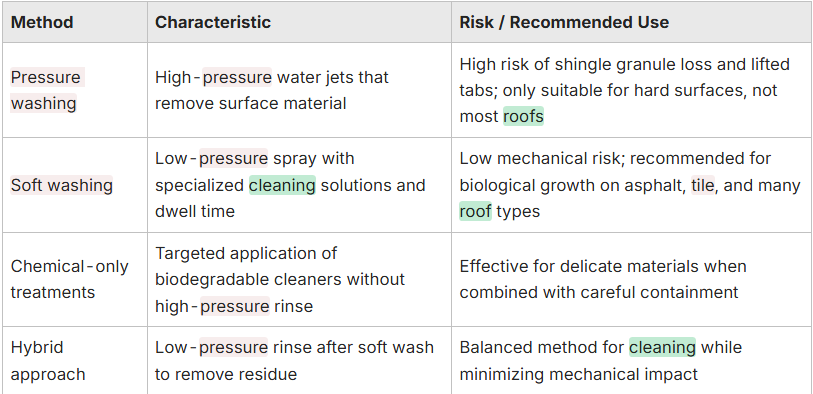
What Are the Dangers of Using the Wrong Roof Cleaning Chemicals?
Using the wrong chemicals for roof cleaning means exposing roofing materials, gutters, landscaping, and drainage systems to corrosive or persistent toxins that cause long-term harm. Chemical mechanisms include oxidation, metal corrosion, and polymer breakdown; for example, undiluted strong bleaches can accelerate corrosion on metal gutters and fasteners while breaking down paint and sealants. Runoff from aggressive agents also travels from roof to gutter to stormwater systems, potentially contaminating plumbing traps and septic systems. The following subsections detail material corrosion, environmental harm, and how runoff contaminates drainage components.
Harsh chemicals corrode roofing components by initiating chemical reactions that strip protective coatings and attack metal alloys and polymer binders. Strong acids and undiluted sodium hypochlorite (bleach) oxidise metal gutters and fasteners, weakening attachment points and creating pinholes that leak. On composite shingles, aggressive oxidisers can remove binders that hold granules, causing granule shedding and accelerated wear. Inspecting material compatibility and using manufacturer-recommended cleaners prevents these chemical failure modes.
Chemical runoff can damage landscaping, soil biology, and local stormwater, especially if plants are not covered or neutralisers are not applied. Plants exposed to concentrated runoff often show leaf burn, slowed growth, and root stress; soil micro-organisms that maintain drainage quality may be harmed as well. In regions with environmental controls, improper containment can also lead to regulatory issues. These environmental concerns encourage using biodegradable cleaners and containment tactics during application.
Runoff follows a predictable path: roof surface → gutters → downspouts → stormwater/drainage or sewer connection, and along the way it can corrode pipe fittings, alter pH in traps, and harm septic biology. Symptoms of chemical contamination in plumbing include metallic tastes in water (if contamination reaches supply, which is rare but possible through cross-connections), foul odours from damaged traps, and accelerated pipe pitting for vulnerable materials. Mapping that runoff path emphasises containment and selection of safe chemicals prior to any roof cleaning project.
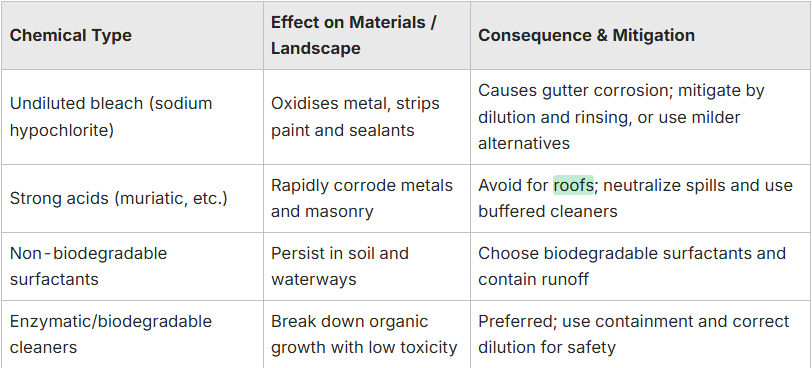
What Safety Errors Should You Avoid During Roof Cleaning?
Safety errors in roof cleaning are primarily about falls, electrical contact, and improper chemical handling; avoiding these mistakes protects people and property. Falls occur when ladders are misused, when roofs are wet and slippery, or when fall-arrest systems are absent. Electric hazards arise when equipment contacts overhead wiring or when water contacts live outdoor circuitry. Proper planning, PPE, and stopping work in unsafe conditions reduce these risks. The next paragraphs list common DIY dangers and contrast them with professional protocols.
Many DIY roof cleaning efforts underestimate fall risks, ladder stability, and the slipperiness of wet roofing surfaces. Common errors include using single ladder tie-offs, standing on unsupported roof edges, and working without a harness or anchor system. These mistakes lead to serious injury or fatality and often cause collateral property damage when tools or equipment fall. Recognising these hazards informs the decision of when to stop DIY work and call a professional.
Professional teams use formal safety protocols to prevent accidents, including trained fall arrest systems, anchor points, PPE, and job hazard analyses before work begins. They follow step-by-step checks for weather, roof load capacity, and electrical proximity, which reduce accident frequency and protect both crew and homeowner. Having professionals execute high-risk tasks also transfers liability and supports safer outcomes. Understanding professional safeguards sets appropriate expectations for equipment and procedures.
Essential equipment and precautions include harnesses, roof anchors, non-slip footwear, soft-wash rigs designed for low-pressure operation, and containment gear for chemicals. Pre-clean checks should confirm roof condition, identify fragile areas, and ensure that power lines are out of reach. When DIYers encounter any uncertainty about stability, roof integrity, or chemical compatibility, pausing and seeking professional inspection prevents accidents and further damage.
- Misused ladders and unsecured setups increase fall risk and should be avoided with proper anchoring.
- Working on wet or moss-covered surfaces without fall protection leads to slips; always use harnesses and non-slip footwear.
- Proximity to power lines during wet work raises electrocution danger; maintain safe distances and de-energise circuits when needed.
- Improper mixing or handling of chemicals causes burns and runoff risks; follow manufacturer dilution and containment instructions.
Why Is Neglecting Gutter and Downspout Maintenance a Key Roof Cleaning Mistake?
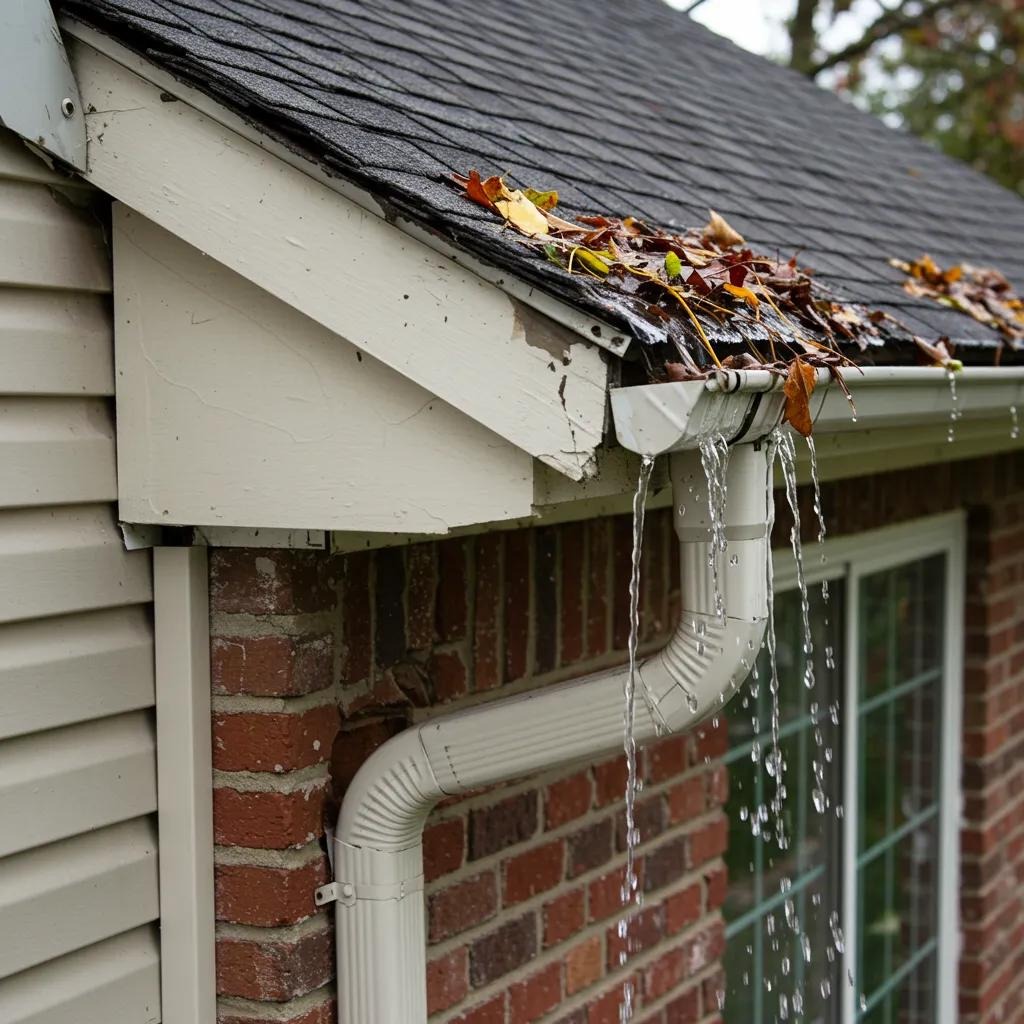
Neglecting gutters and downspouts allows debris to accumulate, which changes water behaviour from controlled conveyance to destructive overflow that harms eaves, foundations, and plumbing. Clogged gutters cause water to pool at roof edges, increasing load and creating seepage that damages fascia and soffit and allows water to reach internal plumbing runs. This mechanical progression explains why gutter maintenance is a core part of any responsible roof cleaning program. The subsequent subsections examine overflow mechanics, plumbing problems, and fascia impacts.
Clogged gutters lead to overflow by blocking the intended flow path and forcing water over the lip during heavy rain, which then soaks eaves and exterior walls. That overflow erodes mortar, penetrates cladding, and accelerates rot in timber fascia and soffit assemblies. Over time, this repeated wetting reduces the structural support for gutter hangers and causes misalignment. Addressing gutter clogging directly prevents these structural failure modes and reduces the need for coordinated roof repairs.
Poor gutter drainage also translates into plumbing problems when water is misdirected toward foundations, stormwater inlets, or sewer connections. Examples include blocked storm outlets causing localised pooling, increased hydrostatic pressure against basements, and sediment-laden flow that clogs municipal drains. Plumbing symptoms can include slow external drains, water in subfloor voids, and basement seepage after storms. Recognising these plumbing consequences highlights when to schedule professional gutter and drain inspections.
Fascia and soffit damage undermines gutter attachment and changes system geometry, which then causes repeated overflow and downstream plumbing stress. When fascia rots, gutter fixings lose purchase and gutters sag, concentrating flow at joints and increasing leak points. Repairing fascia and rehanging gutters restores proper drainage geometry and prevents recurrent plumbing damage. Understanding this structural chain reaction leads naturally to service strategies that address both roof and gutter systems.

How Does Poor Timing and Weather Conditions Impact Roof Cleaning Effectiveness?
Poor timing and unsuitable weather conditions reduce cleaning effectiveness and increase risks such as rapid re-growth of moss and retained moisture that harms structural and plumbing systems. Weather affects chemical dwell times, worker safety, and drying rates; for instance, cleaning before a heavy rain event can wash chemicals into stormwater, while cleaning during high heat reduces worker safety. Choosing the right seasonal window maximises treatment efficacy and minimises water retention risks that lead to mould and plumbing issues. The following subsections discuss weather mistakes, re-growth dynamics, and retention dangers.
Cleaning roofs in extreme weather is a mistake because strong wind, heavy rain, frost, or extreme heat compromise safety and chemical performance. Wind can blow cleaning solutions off target, rain prematurely dilutes dwell-time-dependent products, and frost increases slip hazards and brittle materials. Scheduling work in moderate, dry conditions ensures proper application and safe access. Recognising those limitations helps homeowners plan maintenance windows.
Poor timing also encourages moss and algae re-growth because biological organisms exploit favourable moisture and temperature cycles; cleaning during short dry spells followed by prolonged dampness leads to quick recolonisation. Moss spores persist and regrow when surfaces remain cool and moist, so combining cleaning with preventive treatments and seasonal scheduling reduces recurrence. This timing strategy naturally leads to recommendations for maintenance cadence.
Water retention after cleaning caused by blocked drains, inadequate drying, or poor pitch creates plumbing and structural risks by keeping substrates wet long enough for rot and mould growth. Retained water can migrate into eaves, underlayment, and wall cavities, leading to interior dampness and pipe corrosion near persistent wet zones. Verifying drainage, confirming downspout clearances, and allowing controlled drying times after cleaning are essential checks to avoid these outcomes.
- Schedule cleaning in dry, mild weather with several dry days afterwards to allow surfaces to dry and chemicals to work.
- Inspect and clear gutters and downspouts before cleaning to ensure immediate drainage of rinse water.
- Avoid cleaning immediately before or during expected heavy rain, high winds, or frost conditions.
Following these timing practices reduces re-growth, protects plumbing, and improves the longevity of any cleaning treatment.
How Can Professional Roof Cleaning Prevent These Common Mistakes?
Yes, professional roof cleaning can prevent many common mistakes by applying the correct method, proper chemicals, and safety protocols that protect both roofing materials and plumbing systems. Professionals employ a workflow of inspection, method selection, targeted soft washing, containment, and verification to reduce mechanical and chemical harm. The benefits include safety for occupants and workers, preservation of warranty coverage, and reduced long-term plumbing and structural failures. The next subsections outline specific homeowner benefits, the maintenance workflow, and services available.
Hiring trained experts yields measurable homeowner value because professionals combine local climate knowledge, correct method selection, and safety systems to protect property assets. Benefits include reduced fall risk through fall-arrest systems, method selection (often soft wash) that preserves shingles, and focused containment strategies that minimise chemical runoff into gutters and drains. These protections directly reduce the likelihood of plumbing damage caused by improper cleaning. Understanding these advantages helps homeowners weigh DIY vs professional trade-offs.
Professional maintenance protects roofs and plumbing by following an inspection → clean → repair loop that identifies vulnerabilities before they cause leaks. Inspections reveal loose flashings, clogged outlets, and compromised sealants; targeted cleaning removes biological growth and debris; and small repairs restore geometry and attachment points to ensure proper drainage. This coordinated approach reduces downstream plumbing blockages and prevents water ingress that would otherwise corrode pipes or saturate insulation. The workflow demonstrates why proactive professional maintenance is cost-effective.
Adelaide Roofing and Construction offers professional interventions focused on preserving roof integrity and protecting drainage pathways, using services that prevent common roof cleaning mistakes while prioritising safety and long-term performance. Their process includes careful inspection, method selection favouring soft-wash approaches, containment measures to protect gutters and landscaping, and post-clean verification to confirm drainage and drying. Homeowners seeking an inspection or quote are encouraged to request an assessment that emphasises plumbing protection and damage prevention.
- Safety-first operations using trained crews and fall-protection systems that reduce accident risk during roof access.
- Method selection that emphasises soft washing to protect shingles, extend roof life, and avoid voiding manufacturer warranties.
- Plumbing-protection focus: gutter containment and downspout checks to prevent clogged drains, overflow, and water ingress.
- Local expertise in Adelaide climate conditions to schedule treatments for maximal efficacy and minimal re-growth.
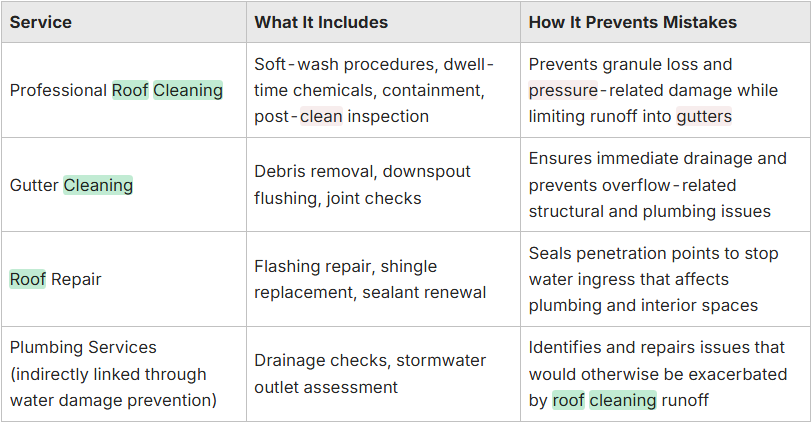
What Are the Best Practices for Safe and Effective Roof Cleaning?
Best practices for safe and effective roof cleaning combine appropriate method selection, safe chemical choices, regular scheduling, and pre/post inspections to maintain performance and protect plumbing. Choosing the right method depends on roof material, growth type, and warranty constraints; selecting safe, biodegradable chemicals minimises environmental and plumbing damage; and a regular maintenance cadence reduces re-growth and cumulative wear. The following subsections provide practical guidance on matching methods to roof types, chemical safety, and recommended maintenance intervals.
Choosing the right cleaning method starts with identifying roof material and common options include asphalt shingles, tile, and metal has applying dos and don'ts for each. Asphalt shingles generally require soft washing and mild enzymatic cleaners to preserve granules; clay or concrete tiles can tolerate slightly stronger actions but still benefit from low-pressure treatments; metal roofs require corrosion-aware cleaners and careful rinsing. Red flags include visible loose shingles, cracked tiles, or evidence of previous pressure damage, which should trigger a professional inspection before cleaning.
Safe and environmentally friendly chemicals include biodegradable surfactants, low-concentration oxidisers formulated for roofs, and enzymatic cleaners that break down organic growth without persistent toxicity. Application best practices require correct dilution, containment of runoff, covering sensitive plants, and neutralisation of spills. Regulatory awareness and local environmental conditions inform product selection to minimise harm to landscaping and drainage systems.
Maintenance cadence recommendations balance roof type and local conditions: an annual inspection and cleaning is common for most suburban roofs, with biannual checks in high-growth or high-rainfall areas. Additional triggers for unscheduled service include after severe storms, visible moss/algae growth, or signs of clogged gutters and downspouts. A consistent schedule prevents heavy buildup, reduces chemical use over time, and protects plumbing by keeping conveyance paths clear.
- Inspect roofs and gutters annually and after major weather events to catch issues early.
- Use soft washing and biodegradable cleaners for most roof materials to reduce mechanical and chemical harm.
- Clear gutters before any roof cleaning so rinse water drains away rapidly and does not pond or overflow.
- Schedule professional assessments when roof condition, pitch, or accessibility raises safety concerns.
Adopting these best practices improves roof longevity, prevents plumbing consequences from neglected drainage, and ensures that cleaning is both effective and safe for the property.

